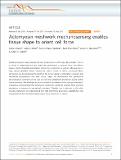| dc.contributor.author | Miller, Callie J. | |
| dc.contributor.author | Ermentrout, Bard | |
| dc.contributor.author | Davidson, Lance A. | |
| dc.contributor.author | Chanet, Soline | |
| dc.contributor.author | Vaishnav, Eeshit Dhaval | |
| dc.contributor.author | Martin, Adam C | |
| dc.date.accessioned | 2018-02-12T15:32:48Z | |
| dc.date.available | 2018-02-12T15:32:48Z | |
| dc.date.issued | 2017-05 | |
| dc.date.submitted | 2016-09 | |
| dc.identifier.issn | 2041-1723 | |
| dc.identifier.uri | http://hdl.handle.net/1721.1/113567 | |
| dc.description.abstract | Sculpting organism shape requires that cells produce forces with proper directionality. Thus, it is critical to understand how cells orient the cytoskeleton to produce forces that deform tissues. During Drosophila gastrulation, actomyosin contraction in ventral cells generates a long, narrow epithelial furrow, termed the ventral furrow, in which actomyosin fibres and tension are directed along the length of the furrow. Using a combination of genetic and mechanical perturbations that alter tissue shape, we demonstrate that geometrical and mechanical constraints act as cues to orient the cytoskeleton and tension during ventral furrow formation. We developed an in silico model of two-dimensional actomyosin meshwork contraction, demonstrating that actomyosin meshworks exhibit an inherent force orienting mechanism in response to mechanical constraints. Together, our in vivo and in silico data provide a framework for understanding how cells orient force generation, establishing a role for geometrical and mechanical patterning of force production in tissues. | en_US |
| dc.description.sponsorship | National Institute of General Medical Sciences (U.S.) (Grant R01GM105984) | en_US |
| dc.description.sponsorship | American Heart Association (Grant 14GRNT18880059) | en_US |
| dc.description.sponsorship | European Molecular Biology Organization (Grant ALTF 1082-2012) | en_US |
| dc.publisher | Nature Publishing Group | en_US |
| dc.relation.isversionof | http://dx.doi.org/10.1038/NCOMMS15014 | en_US |
| dc.rights | Creative Commons Attribution 4.0 International License | en_US |
| dc.rights.uri | https://creativecommons.org/licenses/by/4.0/ | en_US |
| dc.source | Nature Communications | en_US |
| dc.title | Actomyosin meshwork mechanosensing enables tissue shape to orient cell force | en_US |
| dc.type | Article | en_US |
| dc.identifier.citation | Chanet, Soline et al. “Actomyosin Meshwork Mechanosensing Enables Tissue Shape to Orient Cell Force.” Nature Communications 8 (May 2017): 15014 © 2017 The Author(s) | en_US |
| dc.contributor.department | Massachusetts Institute of Technology. Department of Biology | en_US |
| dc.contributor.mitauthor | Chanet, Soline | |
| dc.contributor.mitauthor | Vaishnav, Eeshit Dhaval | |
| dc.contributor.mitauthor | Martin, Adam C | |
| dc.relation.journal | Nature Communications | en_US |
| dc.eprint.version | Final published version | en_US |
| dc.type.uri | http://purl.org/eprint/type/JournalArticle | en_US |
| eprint.status | http://purl.org/eprint/status/PeerReviewed | en_US |
| dc.date.updated | 2018-02-02T19:36:34Z | |
| dspace.orderedauthors | Chanet, Soline; Miller, Callie J.; Vaishnav, Eeshit Dhaval; Ermentrout, Bard; Davidson, Lance A.; Martin, Adam C. | en_US |
| dspace.embargo.terms | N | en_US |
| dc.identifier.orcid | https://orcid.org/0000-0001-9434-0628 | |
| dc.identifier.orcid | https://orcid.org/0000-0001-8060-2607 | |
| mit.license | PUBLISHER_POLICY | en_US |
